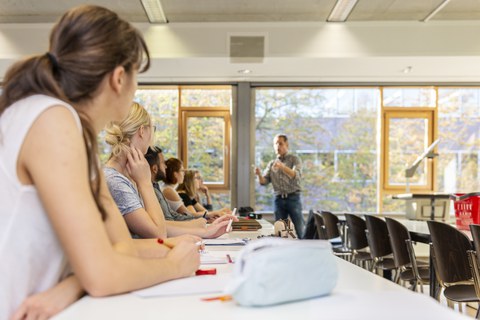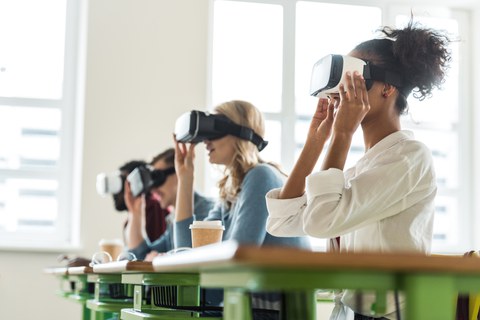Lehr-Lernräume
Die Gestaltung von Lehr-/Lernräumen beeinflusst die Qualität der Lehre sowie die Lernerfahrungen der Studierenden.
Es ist eine komplexe und dynamische Aufgabe, die eine interdisziplinäre Zusammenarbeit zwischen verschiedenen Akteur:innen erfordert.
Dabei geht es nicht nur um die physische Ausstattung und Einrichtung von Räumen, sondern auch um die didaktischen Konzepte und Methoden, die in diesen und digitalen Räumen angewendet werden.
Lehr-/Lernräume sind Orte, an denen Lehrende und Lernende miteinander interagieren, um Wissen zu erwerben, zu vertiefen und zu reflektieren. Diese können sowohl physisch als auch virtuell oder auch hybrid gestaltet sein.
Lehr-/Lernräume können die Motivation, das Engagement und die Zufriedenheit der Lehrenden und Lernenden fördern oder hemmen und die Entwicklung von Kompetenzen und Fähigkeiten unterstützen oder behindern.
Daher ist es wichtig, Räume so zu gestalten, dass sie den Bedürfnissen der Lehrenden und Lernenden entsprechen und ihnen eine optimale Lernumgebung bieten.
Drei grundlegende Arten: Präsenz, Online und Hybrid
Präsenz-Lehr-/Lernräume sind physische Räume, in denen Lehrende und Lernende sich persönlich treffen, um gemeinsam zu lernen. Beispiele für Präsenz-Lehr-/Lernräume sind Hörsäle, Seminarräume, Labore, Bibliotheken oder Makerspaces. Präsenz-Lehr-/Lernräume haben den Vorteil, dass sie eine direkte Kommunikation und Interaktion zwischen den Beteiligten ermöglichen, die Körpersprache, Mimik und Gestik einschließt. Außerdem können Präsenz-Lehr-/Lernräume die soziale Bindung und das Gemeinschaftsgefühl der Lernenden fördern. Präsenz-Lehr-/Lernräume haben jedoch auch Nachteile, wie zum Beispiel räumliche und zeitliche Beschränkungen, hohe Kosten, geringe Flexibilität und mögliche Ansteckungsgefahren. Präsenz-Lehr-/Lernräume können mit digitalen Medien angereichert werden.
Im Campus Navigator können die medientechnische Ausstattung der zentral verwalteten Lehrräume beim jeweiligen Raum unter den Raumbelegungsplänen eingesehen werden (Bsp. HSZ/E05/U). Vor Semesterstarts werden verschiedene Schulungstermine zur verbauten Medientechnik angeboten. Zu den Terminen besteht u. a. die Möglichkeit die Technik zu testen und sich von den Kolleg:innen der Gruppe Medientechnik in Lehr- und Lernräumen zu Anwendungsfragen und -möglichkeiten beraten zu lassen. Die Schulungstermine sowie den Link zur Anmeldung finden Sie auf der Website des Sachgebiets 8.7 - Zentrale Lehr- und Lernräume.
Sollte in Ihrer Fakultät aufgrund besonderer fakultätsspezifischer Anwendungsfelder der Bedarf an einem speziell auf diese Themen abgestimmten Schulungstermin bestehen, setzen Sie sich bitte mit Ronny Petzold in Verbindung. Bitte nutzen Sie die angebotenen Termine, um Fragen im Zusammenhang mit der Nutzung der Medientechnik in den Lehrräumen vorab zu klären. Die Erfahrung hat gezeigt, dass, aufgrund der Vielzahl der zu betreuenden Räume und dem zu Semesterbeginn stark erhöhten Supportbedarf, es den Kolleg:innen nicht möglich ist, allen Supportanfragen vor Ort nachzukommen.
Online-Lehr-/Lernräume sind virtuelle Räume, in denen Lehrende und Lernende sich über digitale Medien verbinden, um gemeinsam zu lernen. Beispiele für Online-Lehr-/Lernräume sind Online-Plattformen, Lernmanagementsysteme oder soziale Netzwerke. Online-Lehr-/Lernräume haben den Vorteil, dass sie eine orts- und zeitunabhängige Kommunikation und Interaktion zwischen den Beteiligten ermöglichen, die verschiedene Medienformate, wie Text, Bild, Audio oder Video, umfasst. Außerdem können Online-Lehr-/Lernräume die individuelle Anpassung und Differenzierung des Lernens unterstützen.
Online-Lehr-/Lernräume haben jedoch auch Nachteile, wie zum Beispiel technische Probleme, geringere soziale Präsenz, hohe Anforderungen an die Selbstregulation und mögliche Überforderung. Synchrone Online-Lehr-/Lernräume sind virtuelle Räume, in denen Lehrende und Lernende sich über digitale Medien verbinden, um gemeinsam und zeitgleich zu lernen. Beispiele für synchrone Online-Lehr-/Lernräume sind Webinare, Live-Streams oder Live-Chats.
Hybrid-Lehr-/Lernräume sind Räume, in denen Präsenz- und Online-Lehr-/Lernräumen kombiniert werden, um gemeinsam zu lernen. Hybrid-Lehr-/Lernräume haben den Vorteil, dass sie die Stärken beider Welten nutzen und die Schwächen ausgleichen können. Außerdem können Hybrid-Lehr-/Lernräume die Vielfalt und Abwechslung des Lernens erhöhen. Hybrid-Lehr-/Lernräume haben jedoch auch Nachteile, wie zum Beispiel hoher Planungs- und Koordinationsaufwand, mögliche Inkonsistenzen und Verwirrungen und unterschiedliche Zugangs- und Teilhabemöglichkeiten.
Eine hybride Lehrveranstaltung (verstanden in dem Sinn, dass einige Studierende in Präsenz vor Ort sind und einige Studierende online an der Lehrveranstaltung teilnehmen) erfolgreich zu gestalten, ist sowohl aus didaktischer als auch technischer Sicht eine große Herausforderung. Um die technische Umsetzung zu unterstützen, wurden 36 mobile Techniksets angeschafft, die zentral für alle Lehrenden der TUD zur Verfügung stehen. Die Sets bestehen aus Kamera mit Tracking-Funktion der redenden Person, Mikrofon, Stativ und Wurfmikrofon (für die Beteiligung der Teilnehmenden im Lehrraum) und sind in einer kleinen Tasche transportierbar. Die Sets können über die Kolleg:innen der Medientechnikausleihe (HSZ E11) vorgemerkt und ausgeliehen werden. Informationen zur Bedienung finden Sie u. a. in einem Video der Kolleg:innen des Karlsruher Institut für Technologie. In einer Kurzanleitung sind darüber hinaus die wichtigsten Informationen für den Einsatz der mobilen Sets an der TUD zusammengefasst.
Darüber hinaus ist eine Verlinkung zu Ihren OPAL-Kursen auf Ihrer Webseite und im Vorlesungsverzeichnis sinnvoll. Eine Übersicht zu mit für hybride Lehrformate ausgestatteten, zentral verwalteten Lehrräumen existiert verlinkt auf der Website des Sachgebiets 8.7 – Zentrale Lehr- und Lernräume.
Extended Reality als weiterer Lernort
Sowohl innerhalb als auch außerhalb der Universität stößt man mittlerweile vermehrt auf Anwendungen, die den Bereichen Virtual Reality (VR), Augmented Reality (AR), Mixed Reality bzw. Extended Reality (XR) zuzuordnen sind.
Ähnlich wie Mixed Reality bezieht sich der Begriff Extended Reality (XR) auf die Kombination realer und virtueller Umgebungen und ihrem vielfältigen Zusammenspiel.
Der Begriff wird somit als Dachbegriff für alle Anwendungen genutzt, in denen die reale Welt ergänzt oder durch eine rein digitale Umgebung ersetzt wird.
Als dritter Lernort können XR-Umgebungen genutzt werden, um eine Verbindung zwischen Theorie und Praxis herzustellen:
- Studierende beschäftigen sich nicht rein theoretisch mit einer Problemstellung, sondern können Kompetenzen in unterschiedlichen Berufs- und Forschungsumgebungen weiterentwickeln.
Beispiele an der Technischen Universität Dresden
Im Immersive Experience Lab (IXLAB) erforscht die Juniorprofessur für Gestaltung Immersiver Medien unter Leitung von Prof. Matthew McGinity interdisziplinär die Grundlagen, Technologie, Anwendungen und Implikationen immersiver Medien - Medien, in denen virtuelle und entfernte Menschen, Objekte, Ereignisse oder Welten als real und gegenwärtig erlebt werden.
Im IXLAB werden eine Reihe verschiedener Projekte umgesetzt. Diese verbinden Elemente der Wahrnehmungs- und Kognitionswissenschaft, des Weltenbaus und der spekulativen Simulation, der Informatik und des Ingenieurwesens, der Philosophie, der Phänomenologie sowie der Kunst und des Designs. Unter anderem wird so in Zusammenarbeit mit Lehrenden verschiedener Fachdisziplinen zur Weiterentwicklung und Gestaltung immersiver Lern-Lehrräume geforscht.
Mehr zu den einzelnen Projekten erfahren Sie auf den Seiten des Immersive Experience Lab.
Bildungsangebote – wie beispielsweise Vorlesungen, Kurse oder Fachtagungen – finden zunehmend im hybriden oder virtuellen Raum statt. Etwa im Gegensatz zu konventionellen Videokonferenzwerkzeugen bieten immersive Medientechnologien wie Virtual Reality (VR) die Möglichkeit, hierbei den räumlich-situativen Charakter von Bildungsprozessen zu wahren. Um didaktische Szenarien für solche virtuellen Lernwelten zu entwickeln und Gelingensbedingungen hinsichtlich ihrer Gestaltung, Umsetzung und ihres Einsatzes empirisch zu fundieren, werden im Vorhaben „AVILAB2“ im Bereich der Hochschulbildung verschiedene Anwendungsszenarien entwickelt und erprobt. Dazu zählen u. a. virtuelle Seminare, virtuelle Labore, digitale Zwillinge und Simulationen sowie virtuelle Fachkonferenzen. Ein Schwerpunkt liegt hierbei auf der sozialen Integration der Lernenden. Die technische Umsetzung erfolgt unter Verwendung der VR-Software „TriCAT spaces“.
Das Projekt ist am Center for Open Digital Innovation and Participation (CODIP) verortet. Mehr Informationen erhalten Sie auf der „AVILAB2“-Projektseite.
VR-Simulationen werden in der Ausbildung von Gesundheits- und Pflegefachberufen zunehmend als innovative Lehrmethodik eingesetzt. Sie bieten den Lernenden eine immersive Lernumgebung, in der realitätsnahe Szenarien erlebt und trainiert werden können, ohne dass echte Patient:innen involviert sind.
Im Projekt VRinSim haben Studierende der Professur für Gesundheit und Pflege/Berufliche Didaktik eigenständig exemplarische Virtual-Reality Szenarien erstellt. Die technische Umsetzung erfolgte anhand von 360 Grad Kameras, dem Autorentool PaneoVR sowie entsprechenden VRBrillen. Im Wintersemester 2022/23 entstanden so im Rahmen einer Lehrveranstaltung von Prof. Anja Walter und Martin Karstädt in einer ersten Pilotierungsphase zwölf Szenarien. Das Lehr-Lernkonzept wurde mit Unterstützung des ZiLLs ausgewertet und weiterentwickelt und wird im Januar 2024 in die zweite Pilotierungsphase starten.
Die Umsetzung des Projektes VRinSim findet im Rahmen des von der Stiftung für Innovation in der Hochschulehre geförderten Verbundprojektes D2C2 statt. Unterstützung erfolgte zudem vom Simulationslabor der Evangelischen Hochschule Dresden, dem Medizinischen Interprofessionellen Trainingszentrum, den LERNFUTURISTEN sowie, durch die Bereitstellung der Software PaneoVR durch das Projekt ViRDiPA.
XR-Community@TUD
Die oben genannten Projekte geben nur einen exemplarischen Einblick in die Vielfalt von XR-Projekten an der TU Dresden. Mittlerweile kommen XR-Applikationen in allen Fachbereichen der TU Dresden zum Einsatz. Um Ressourcen zu bündeln und bestehende Expertise sichtbar zu machen, initiierte das ZiLL im Frühjahr 2023 die XR-Community@TUD. Seit Mai 2023 treffen sich im Rahmen der Community interessierte Lehrende und Forschende regelmäßig, um sich ihre Projekte gegenseitig vorzustellen, sich über neuste Entwicklungen im Bereich Extended Reality auszutauschen und über mögliche Kooperationen zu sprechen.
Möchten Sie mehr über die Community erfahren und an einem der nächsten Treffen teilnehmen? Über eine unverbindliche Anmeldung im OPAL Kurs der Community erhalten Sie regelmäßige Einladungen und Updates zu den neusten Aktivitäten.
Ihre Ansprechpersonen bei der Planung von Lehr- und Lernräumen
Im Sachgebiet Zentrale Lehr- und Lernräume sind die Vergabe der zentral verwalteten Lehrräume für Lehrveranstaltungen, Prüfungen und sonstige Veranstaltungen, das zentrale Lehrveranstaltungsmanagement sowie die Planung und Betreuung der medientechnischen Ausstattung in den zentral verwalteten Lehrräumen verankert. Hier finden Sie Ansprechpersonen zu Medientechnik in Lehr- und Lernräumen, insb. zu
- Ausleihe von Medientechnik
- Ausleihe und Betreuung der Video-, Foto- und Audiovisueller-Ausrüstung für Lehre, Forschung und Studium.
- Lehrraumbetreuung
- Kontakt zur Störungsbeseitigung.
- Vorlesungsaufzeichnung / technischer Support für digitale Lehre
- Unterstützung bei der Aufzeichnung von Lehrveranstaltungen sowie der Produktion von lehrunterstützendem Videomaterial. Bereitstellung von Technik und Fachwissen für einen fertigen Videostream.
Desweiteren finden Sie Ihre Ansprechpersonen zur Zentrale Lehrraumbewirtschaftung/Raum- und Stundenplanung.
Die Raumplanung für schriftliche Prüfungen, die innerhalb der vierwöchigen Kernprüfungszeit, aber auch semesterbegleitend stattfinden können, erfolgt in inhaltlicher Abstimmung mit den Prüfungsämtern und ggf. Prüfungsverantwortlichen über den Antrag Raumanforderung für Prüfungen.
Die Semesterstundenplanung erfolgt insbesondere für regelmäßig stattfindende Lehrveranstaltungen in wechselseitiger Abstimmung mit den Stundenplanbeauftragten der Fakultäten, Fachrichtungen und Zentralen Wissenschaftlichen Einrichtungen, ggf. unter Nutzung des Antrages auf Verlegung von Lehrveranstaltungen.

